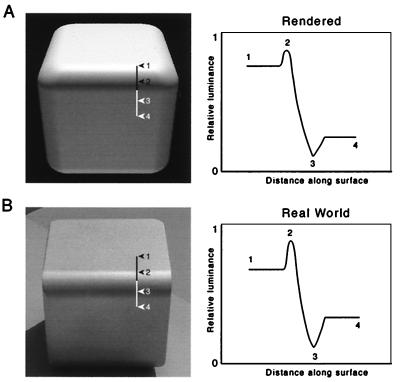Figure 7.
Comparison of the luminance profile determined for the model in Figs. 4–6 with the luminance profile measured across a similarly curved surface of a real object in sunlight. (A) Left shows the model cube in the preceding several figures, here accorded both Lambertian and specular properties, and rendered as if illuminated by both direct and indirect light (i.e., a model that incorporates the conditions of illumination and surface qualities presented independently in Figs. 4–6). Right shows the luminance gradient measured along the line across the curved edge of the cube; numbers indicate corresponding points. (B) Digital photograph of an actual aluminum cube (polished to a reflectance of about 33%) with a rounded edge (radius of curvature = 0.95 cm) illuminated by the sun (near its highest point). Right shows the corresponding luminance profile measured along the line across the curved edge, as in A. The photometrically determined luminance gradients of both the model and its real-world counterpart are similar to the illusory profile perceived in response to viewing stimuli that elicit Mach bands (see Figs. 1 and 3). (Note that the perception of the two cubes presented here does not necessarily represent their luminance profile any more accurately than does the perception of the stimuli in Figs. 1 and 3, in which illusory Mach bands are apparent).

